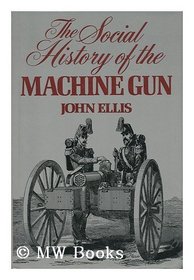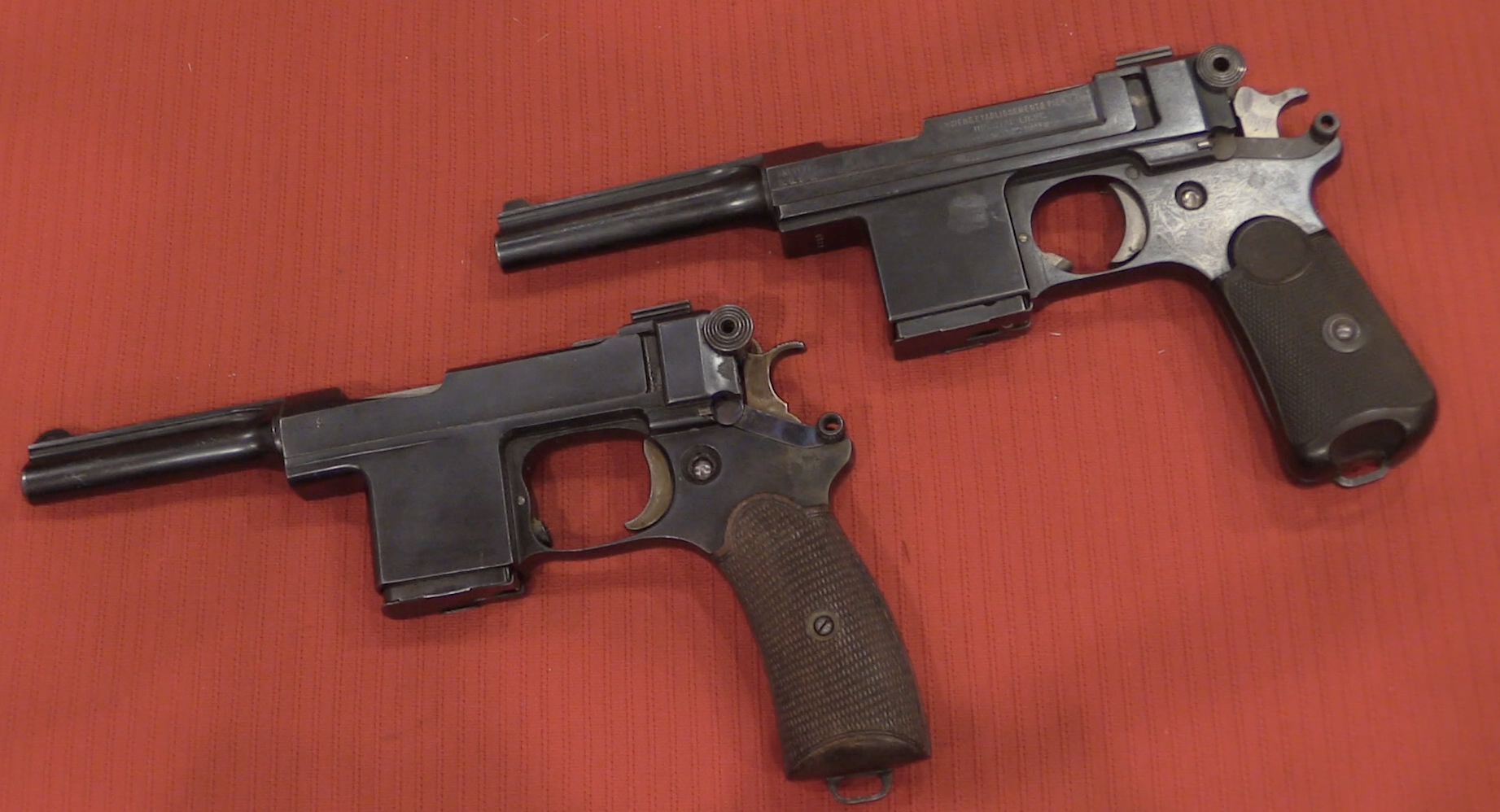 I wasn’t really sure what to expect when I opened up John Ellis’ The Social History of the Machine Gun – machine guns and social histories of anything don’t really tend to go together. Ellis has a fairly extensive list of books to his name, but the jacket describes him as a former member of the Department of Military Studies at the University of Manchester, without claiming the title of Professor.
I wasn’t really sure what to expect when I opened up John Ellis’ The Social History of the Machine Gun – machine guns and social histories of anything don’t really tend to go together. Ellis has a fairly extensive list of books to his name, but the jacket describes him as a former member of the Department of Military Studies at the University of Manchester, without claiming the title of Professor.
It doesn’t take many pages before it becomes evident that Ellis is not a “gun guy”. He has a lot of information at his disposal, but he finds no joy or intrigue in the mechanics of guns. As he describes the development of automatic weapons from the Puckle Gun through the Gatling, Maxim, Lewis, and Browning there is an undercurrent of disgust for the men who designed the guns. He really tries to portray them as merchants of death, eager to sell away the lives of other men to make a buck. He makes suggestion of Gatling simultaneously selling to both the Union and Confederacy in the American Civil War, although this suggestion is pretty solidly disproven today. In fairness, he does have to acknowledge the actions of Lewis and Browning in refusing royalty payments for guns sold to the US military. Instead, he simply focuses on the facts that best support his views, like the no-holds-barred subterfuge of Zaharoff (the predominant traveling salesman for Nordenfelt and then Maxim, who was not above lies and bribery to win contracts).
Overall, the tone and viewpoint of the author is what you would, in fact, expect form a “Social History” – it is a tale of detestable white men with guns. However, one can always learn from different perspectives, and this case is, for me at least, an excellent example of that. When Ellis gets into the meat of the book his perspective bring some interesting things to light that I had not had much knowledge of.
The bulk of the book is divided between European colonial use of machine guns and the First World War. The colonial adventures were definitely the highlight of the book for me, with the analysis of the European attitudes towards warfare and how this influenced weaponry and tactics. Basically, the major western powers’ (Britain, France, and Germany) military forces were led by rather conservative types whose experience in warfare was largely based on elan and esprit de corps – the Napoleonic perspective on warfare. That willpower and morale were more important to the outcome of a battle than any particular weaponry that might be used. There is a lot of truth in this, but it must be the beginning of a discussion on tactics, not the end.
In colonial expeditions, the regular notions of proper warfare were left behind, because the conditions were dramatically different. A small expedition fighting against large numbers of indignant natives had no choice but to rely on technology, and it was in this context that machine guns saw most combat prior to WWI. Britain in particular made good use of them in Africa, while staunchly refusing to open the regular Army to their use. Ellis catalogs numerous campaigns and engagements using a variety of early machine guns (both Maxims and manually-operated guns), and the lessons learned by the commanders who used them. Of course, these lessons were generally ignored by the home army as unrelated to continental warfare (especially by the British – the Germans were much more receptive to the new technology). These campaigns are not commonly documented (at least not in my experience), and it was quite interesting to read about them.
The section on World War I is also worth reading, although it covers material that is much more generally known. Overall, there is definitely enough valuable and thought-provoking material here to be worth the price of the book – especially when it can be had used on Amazon for just over $2. At full price I would waffle on whether to buy or not (and probably wouldn’t), but a used copy is certainly worth the purchase price.
Note – the photo above is the cover of the edition I read, but there are several other cover illustrations for different editions



“Whatever happens
We have got
The Maxim gun
And they have not.” Belloc
Books like this always make me wonder just who the audience is supposed to be or if there is one.
Well… I find Hiram Maxim rather detestable myself!
Thanks for the review.
Joh Ellis wrote a book about WWI on the Western Front, _Eye Deep in Hell_ that I think is still in print.
As far as _Social History of the Machine Gun_ goes, in my view it is superseded and even subsumed by the excellent C.J. Chivers’ _The Gun_ (Simon & Schuster, 2010) ISBN: 978-0-7432-7173-8.
http://cjchivers.com/aboutthegun
Now, the Kalashnikov hardly rates status as a “forgotten weapon” of course, in fact Chivers points out it is one of the most widely recognized objects world-wide, but the tale of its development and distribution certainly has very many forgotten aspects. I highly recommend the Chivers book! A “must have”
I haven’t read Chivers’ book yet, but it’s on my list for sure.
C.J. Chivers did a great job with “The Gun”. I heard a memorable interview on National Public Radio ( NPR ) some time ago on “Fresh Air” where veteran host Terry Gross did an in-depth session with him about this topic. I was very impressed with the open honesty, consistency and respect for hard facts that both of them exhibited, while not neglecting the cost to humanity and the implications for current and future generations. Since NPR archives its programmes for public reference ( much like the Library Of Congress ), anyone who wants to listen to this interview can pull it up by accessing http://www.npr.org and surfing the links or searching directly for this particular episode. It has a lot of interesting information and an excellent broad-spectrum view of the socio-economic history and ramifications thereof of the AK-47.
I consider any alternative view to be an antidote to remaining sane. Why humanity needs weapons (not just guns)? We need them to keep each other in due attention and respect. There is nothing criminal or evil about them. There is notning to blame for the inventors and designers. It’s all with us as we are.
Denny, I think you’ve just highlighted the essence of one unfortunate side of human nature.
Having acquired and read “The Social History Of The Machine Gun” some time back I must agree with you on several points. Despite his credentials John Ellis has an annoying style to his writing. OTOH he is a respected writer on warfare and the military. But he is not focused on the “hardware” aspects of warfare and in fact may well not care for it! He is well focused on the African and other colonial campaigns. For an even better overview of these you should read “Queen Victoria’s Little Wars!
Bill in Boulder
Bill in Boulder – I have a copy of Farwell’s “Queen Victoria’s Little Wars”. I like to use a rule of thumb that if you are evaluating a book on a subject that you are largely not familiar with, then you should look to see if it does cover a topic you do know something about and see if that part of it is correct. Farwell’s account of the Red River Rebellion in Canada in “Queen Victoria’s Little Wars” is utter rubbish and I would not recommend the book to anyone on that basis.
You would expect that someone who writes “social histories” would at least get the “social” part of his histories correct, but just about everything he had to say about the people, causes, background, and goals of the “rebellion” was wrong. I realize that an adequate description of what was a complex set of events would require an entire book in itself, but his brief summary would leave a reader with a very misleading impression of what really went on.
Farwell also mentioned several other “little” Canadian wars. His account of the 1837 Rebellion mentions the farce with Mackenzie, but somehow manages to completely ignore the far more serious threat posed by Papineau. His account of the Fenian Raids was similarly strangely selective. The war with the American insurgents which culminated in the “Battle of the Windmill” is missing altogether. The most “military” of the “little Victorian wars” in Canada (the North West Rebellion) wasn’t even mentioned by name, only just a brief sentence that Riel was hanged.
Given this, I would really hesitate to read another one of his books unless it was on a topic that I was very familiar with so that I could ignore the parts where he had gone wrong. And if I already knew a lot about the topic, then why would I buy his book on it?
So to Ian – if you found the topic covered by his book interesting, then I would suggest reading some other books covering the same field which have good reviews by people who know the subject. There is a lot of historical rubbish out there, and it’s hard to tell what is right or wrong if you are not an expert on the subject.
Somewhat related question. I am looking to buy a Vickers Machine Gun. Can anyone recommend a good book on the gun. Both technical, historical and current.
Thanks- sorry to steal the post
One of my favorites, a detailed account of the industrialization of warfare on the most intimate level. I recommend also “Brute Force”, also by John Ellis, which takes the topic to the global scale as a logistic analysis of WWII.
The audience for this book is anyone who has the intellectual honesty and generosity to at least listen to a viewpoint not quite their own and give it a fair hearing. This includes generals as well as pacifists. The social results of the rise of the machine gun (as a subset to the spread of war itself) are staggering, and affect gun people and non-gun people; therefore they are worth thinking about, as we really do all live in the same world.
I recommend the military histories of John Keegan for the same reason. I would recommend Mr. Chivers’ “The Gun” also for the same reason. I would recommend Mr. Ellis’ book (really, you have to be a Professor to write good history?) to anyone willing to broaden his/her own horizons. I think that book’s ultimate thesis, that the MG logically led to the atom bomb, to be both reasonable and sobering.